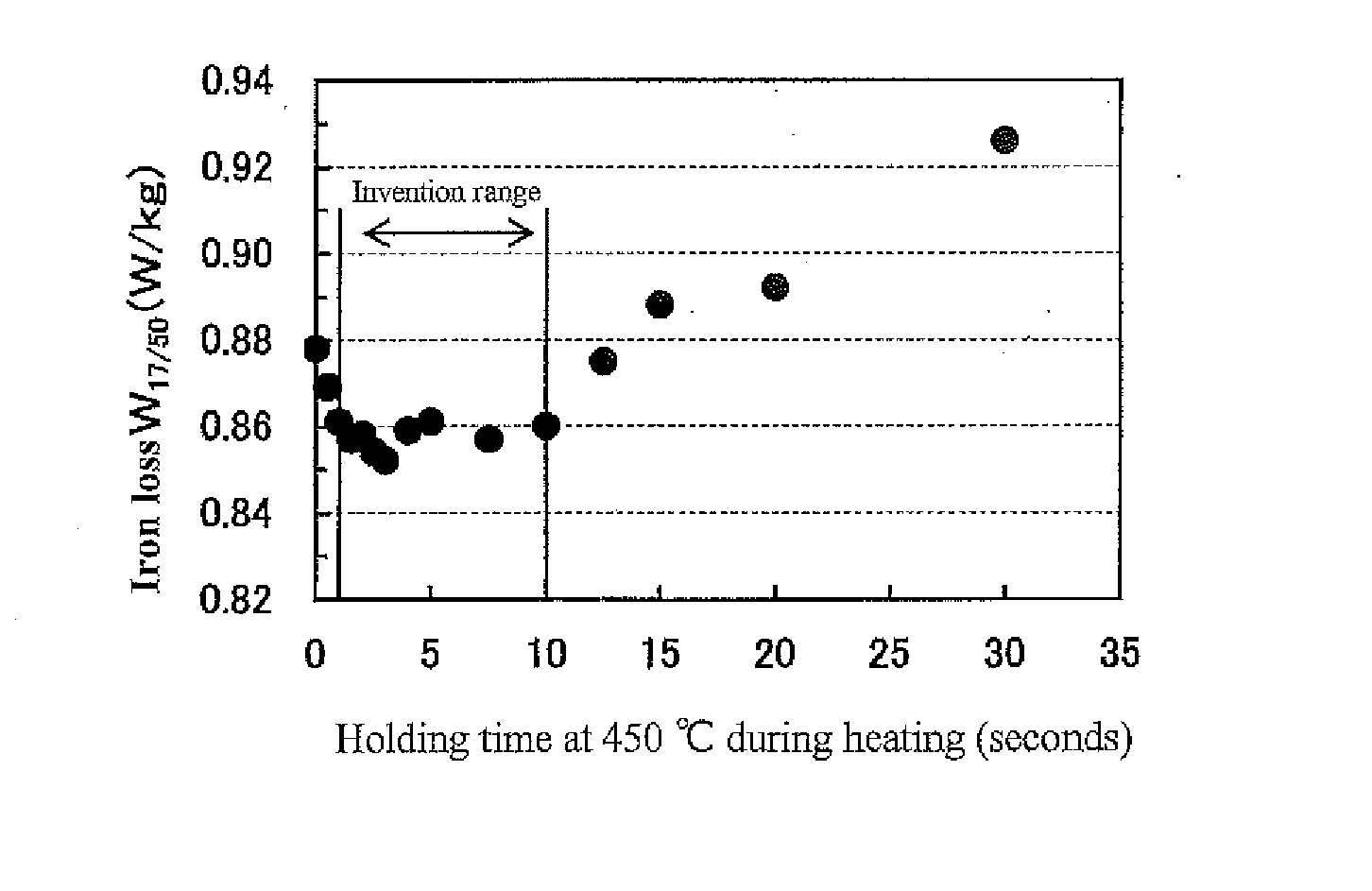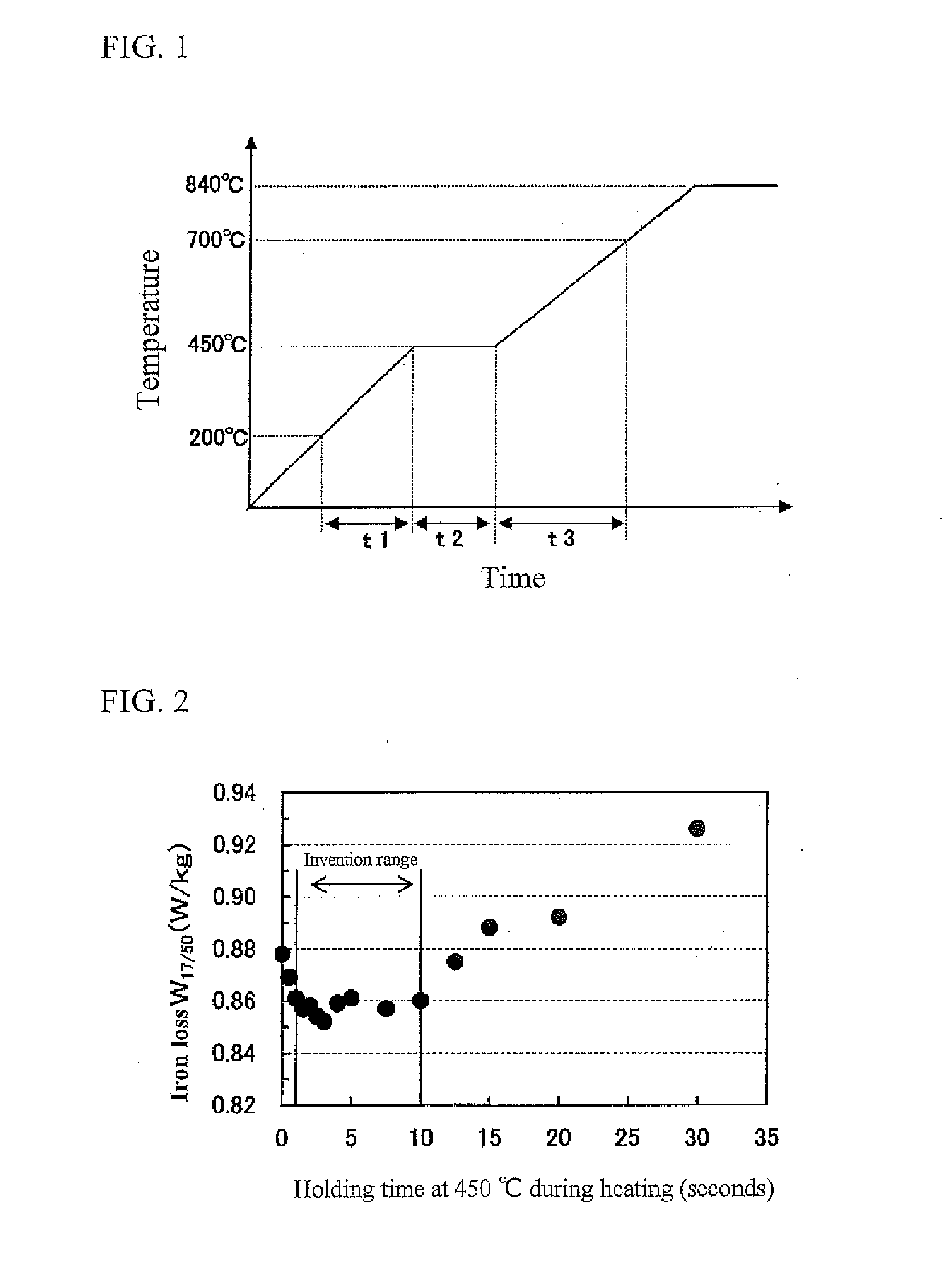Method for producing grain-oriented electrical steel sheet
a technology of electrical steel and grain, which is applied in the direction of heat treatment apparatus, magnetic bodies, furnaces, etc., can solve the problems of large deviation of iron loss property resulting from temperature variation inside the steel sheet in heating, and the inability to achieve the desired effect of rapid heating
- Summary
- Abstract
- Description
- Claims
- Application Information
AI Technical Summary
Benefits of technology
Problems solved by technology
Method used
Image
Examples
experiment 1
[0021]A steel material containing C: 0.065 mass %, Si: 3.44 mass % and Mn: 0.08 mass % is melted and continuously cast into a steel slab, which is hot rolled after reheating at 1410° C. to obtain a hot rolled sheet of 2.4 mm in thickness. The hot rolled sheet is annealed at 1050° C. for 60 seconds, subjected to a primary cold rolling to an intermediate thickness of 1.8 mm and further to an intermediate annealing at 1120° C. for 80 seconds and then warm-rolled at 200° C. to obtain a cold rolled sheet having a final sheet thickness of 0.27 mm.
[0022]Next, the cold rolled sheet is subjected to decarburization annealing combined with primary recrystallization annealing in a wet atmosphere of 50 vol % H2-50 vol % N2 at 840° C. for 80 seconds. The decarburization annealing is performed by setting a heating rate from 200° C. to 700° C. in the heating process up to 840° C. to 100° C. / s and further holding at 450° C. for 0˜30 seconds on the way of the heating. The heating rate of 100° C. / s me...
experiment 2
[0024]The cold rolled sheet obtained in Experiment 1 and having a final thickness of 0.27 mm is subjected to a decarburization annealing in a wet atmosphere of 50 vol % H2-50 vol % N2 at 840° C. for 80 seconds. The heating rate in the decarburization annealing is set to 100° C. / s and further holding at any temperature within a range of 200˜700° C. once for 2 seconds in the heating process is performed. Thereafter, the steel sheet is coated with an annealing separator composed mainly of MgO, dried and subjected to a final annealing including a secondary recrystallization annealing and a purifying treatment of 1200° C.×7 hours in a hydrogen atmosphere.
[0025]A specimen is cut out from the product sheet thus obtained as in Experiment 1 to determine an average iron loss value W17 / 50 by a method described in JIS C2556. The average iron loss values are shown in FIG. 3 in a relation to the holding temperature. As seen from this result, the iron loss is reduced when the holding temperature i...
example 1
[0054]A steel slab comprising C: 0.070 mass %, Si: 3.35 mass %, Mn: 0.10 mass %, Al: 0.025 mass %, Se: 0.025 mass %, N: 0.012 mass % and the remainder being Fe and inevitable impurities is manufactured by a continuous casting method, heated to a temperature of 1420° C., and then hot rolled to 2.4 mm in thickness. The hot rolled sheet is annealed at 1000° C. for 50 seconds, subjected to a first cold rolling to an intermediate thickness of 1.8 mm, annealed at 1100° C. for 20 seconds and then subjected to a second cold rolling to obtain a cold rolled sheet having a final thickness of 0.27 mm.
[0055]Thereafter, the cold rolled sheet is subjected to decarburization annealing in a wet atmosphere of 50 vol % H2-50 vol % N2 at 840° C. for 100 seconds. In this case, a heating rate in a zone of 200˜700° C. during the heating process up to 850° C. is changed as shown in Table 1, while for the temperature and time shown in Table 1 holding on the way of the heating is performed.
[0056]Then, the st...
PUM
| Property | Measurement | Unit |
|---|---|---|
| temperature | aaaaa | aaaaa |
| temperature | aaaaa | aaaaa |
| temperature | aaaaa | aaaaa |
Abstract
Description
Claims
Application Information
 Login to View More
Login to View More - R&D
- Intellectual Property
- Life Sciences
- Materials
- Tech Scout
- Unparalleled Data Quality
- Higher Quality Content
- 60% Fewer Hallucinations
Browse by: Latest US Patents, China's latest patents, Technical Efficacy Thesaurus, Application Domain, Technology Topic, Popular Technical Reports.
© 2025 PatSnap. All rights reserved.Legal|Privacy policy|Modern Slavery Act Transparency Statement|Sitemap|About US| Contact US: help@patsnap.com



